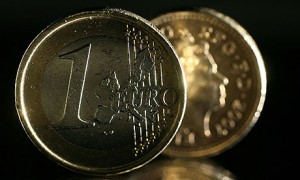 Yesterday’s trade saw EUR/GBP within the range of 0.7233-0.7282. The pair closed at 0.7258, losing 0.25% on a daily basis.
Yesterday’s trade saw EUR/GBP within the range of 0.7233-0.7282. The pair closed at 0.7258, losing 0.25% on a daily basis.
At 7:55 GMT today EUR/GBP was down 0.12% for the day to trade at 0.7249. The pair touched a daily low at 0.7240 at 6:15 GMT.
Fundamentals
Euro area
Italian GDP – final estimate
The final estimate of Italys annual Gross Domestic Product probably pointed to a 0.3% contraction in the fourth quarter of 2014, according to the median forecast by experts, while confirming the preliminary estimate, released on February 13th. In Q3 economy shrank at an annualized pace of 0.4%, according to final data.
On a quarterly basis, Italian economy probably showed no growth in Q4 2014, following a negative growth rate of 0.1% during the third quarter. If so, this would be the 14th consecutive quarter without any expansion. According to provisional data, exports positively contributed to the GDP, while inventories weighted down on growth. On the production side, sectors of agriculture and industry contracted, while services registered an expansion.
In case a lower-than-projected rate of growth was reported, this would have a negative effect on the single currency. The National Institute of Statistics (Istat) will release the final GDP data at 9:00 GMT.
ECB policy decision
At 12:45 GMT the European Central Bank (ECB) is to announce its decision in regard to borrowing costs. The median estimate by experts suggests that the central bank will probably maintain its benchmark interest rate at the record low level of 0.05% at the policy meeting today. The bank last reduced the refinancing rate by 10 basis points to the current 0.05% at the September 4th meeting. This has been the fourth time last year, when the ECB cut its benchmark.
At its meeting on January 22nd the central bank kept the marginal lending facility intact at 0.30% and the deposit facility at -0.20%. The bank has also announced an asset-purchasing program of 60 billion euros per month. Under this program, the ECB will buy public and private sector assets starting March 2015 until September 2016.
According to extracts from the Introductory statement to the press conference, offered by ECB President, Mario Draghi: ”In March 2015 the Eurosystem will start to purchase euro-denominated investment-grade securities issued by euro area governments and agencies and European institutions in the secondary market. The purchases of securities issued by euro area governments and agencies will be based on the Eurosystem NCBs’ shares in the ECB’s capital key.”
”The Governing Council decided to change the pricing of the six remaining targeted longer-term refinancing operations (TLTROs). Accordingly, the interest rate applicable to future TLTRO operations will be equal to the rate on the Eurosystem’s main refinancing operations prevailing at the time when each TLTRO is conducted, thereby removing the 10 basis point spread over the MRO rate that applied to the first two TLTROs.”
“With regard to the sharing of hypothetical losses, the Governing Council decided that purchases of securities of European institutions (which will be 12% of the additional asset purchases, and which will be purchased by NCBs) will be subject to loss sharing. The rest of the NCBs’ additional asset purchases will not be subject to loss sharing. The ECB will hold 8% of the additional asset purchases. This implies that 20% of the additional asset purchases will be subject to a regime of risk sharing.”
ECB policy makers aim to keep prices in the region stable, while stability is defined as a year-on-year increase in the Harmonized Index of Consumer Prices (HICP) for the Euro zone of below, but close to 2%.
Short-term interest rates are of utmost importance for the valuation of national currencies. In case the European Central Bank is dovish about inflationary pressure and overall economic activity in the Euro area and, thus, either puts interest rates on hold, or reduces them further, this will usually cause a bearish impact on the common currency.
The interest rate decision is to be followed by the press conference with ECB President Mario Draghi, during which volatility of euro crosses is usually high. In case Draghi offers a more hawkish tone, the euro will usually receive support, while a more dovish tone will have a bearish effect on the currency. The press conference is scheduled at 13:30 GMT.
United Kingdom
BoE policy decision
At 12:00 GMT Bank of England is to announce its decision on monetary policy. The benchmark interest rate (repo rate) will probably be left unchanged at the record low level of 0.50%. The rate has been at that level since BoEs policy meeting on March 5th 2009. The repo rate applies to open market operations of the central bank with other banks, building societies, securities firms etc. Maintaining or reducing the repo rate usually leads to a sell-off in the national currency.
At the same time, the pace of BoE’s monetary stimulus will probably be left without change as well, at GBP 375 billion. The asset-purchasing programme, financed by the issuance of central bank reserves was started on March 5th 2009, while the scale of this programme was increased by GBP 50 billion to the current GBP 375 billion on July 5th 2012. The central bank issues new money in order to purchase gilts from private investors, such as pension funds and insurance companies.
The banks most recent Inflation Report outlined concerns that inflation rate in the UK is more likely than not to fall below zero. According to extracts from the banks Inflation Report, released in February: ”CPI inflation was 0.5% in December 2014, well below the 2% target. The main reason for this was the steep fall in wholesale energy prices during the second half of last year. Inflation is likely to fall further in the near term, and could temporarily turn negative, as falls in energy prices continue to be passed through. Inflation is likely to rebound around the turn of the year as these effects drop out of the annual rate.”
“At its meeting on 5 February, the MPC noted that conditional on interest rates following the path currently implied by market yields, it was likely that slack in the economy would be absorbed and inflation would return to the 2% target within two years.”
“The MPC stands ready to take whatever action is needed, as events unfold, to ensure inflation remains likely to return to target in a timely fashion. Under the central case, the MPC judges it more likely than not that Bank Rate will increase over the forecast period.”
According to expectations, the central bank may introduce the first rate hike in almost six years in the spring of 2015, after parliamentary election in May.
Pivot Points
According to Binary Tribune’s daily analysis, the central pivot point for the pair is at 0.7258. In case EUR/GBP manages to breach the first resistance level at 0.7282, it will probably continue up to test 0.7307. In case the second key resistance is broken, the pair will probably attempt to advance to 0.7331.
If EUR/GBP manages to breach the first key support at 0.7233, it will probably continue to slide and test 0.7209. With this second key support broken, the movement to the downside will probably continue to 0.7184.
The mid-Pivot levels for today are as follows: M1 – 0.7197, M2 – 0.7221, M3 – 0.7246, M4 – 0.7270, M5 – 0.7295, M6 – 0.7319.
In weekly terms, the central pivot point is at 0.7302. The three key resistance levels are as follows: R1 – 0.7361, R2 – 0.7469, R3 – 0.7528. The three key support levels are: S1 – 0.7194, S2 – 0.7135, S3 – 0.7027.





